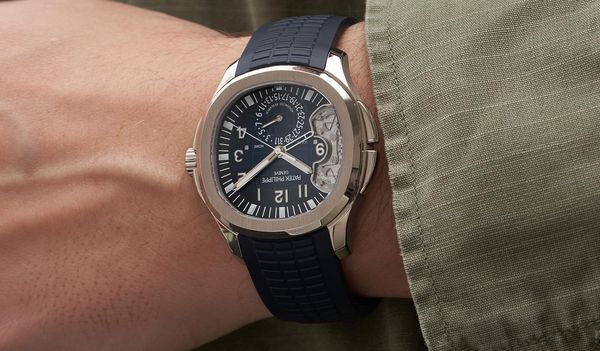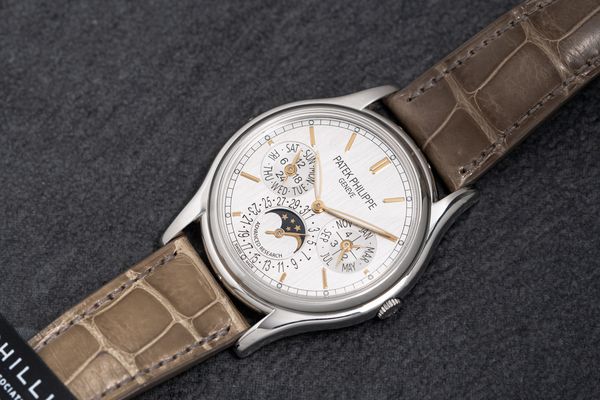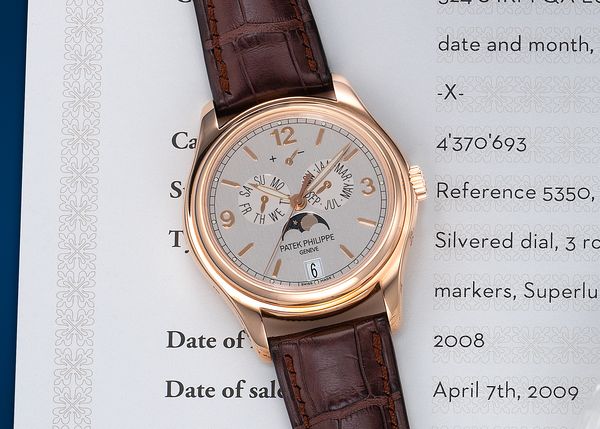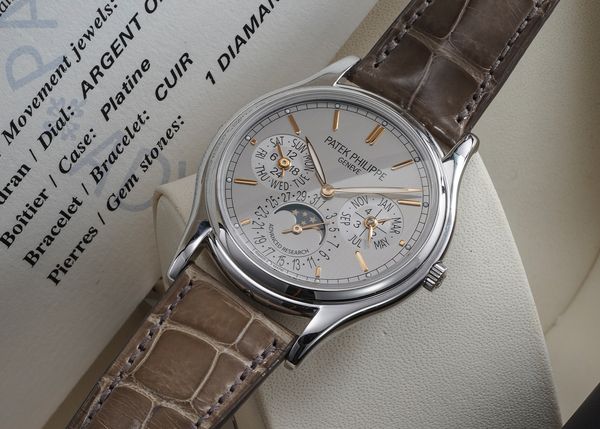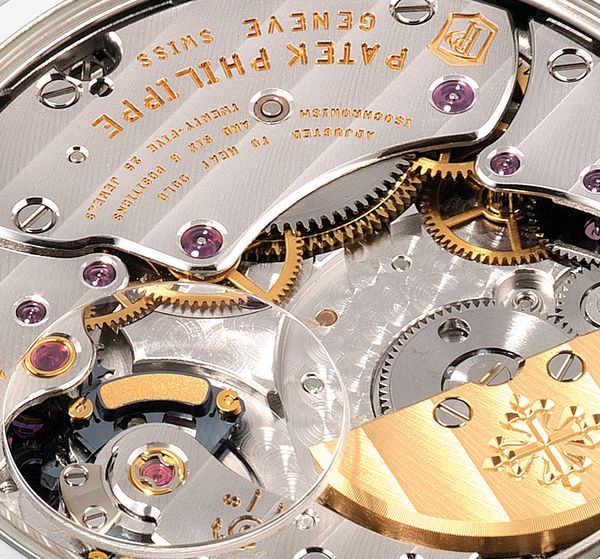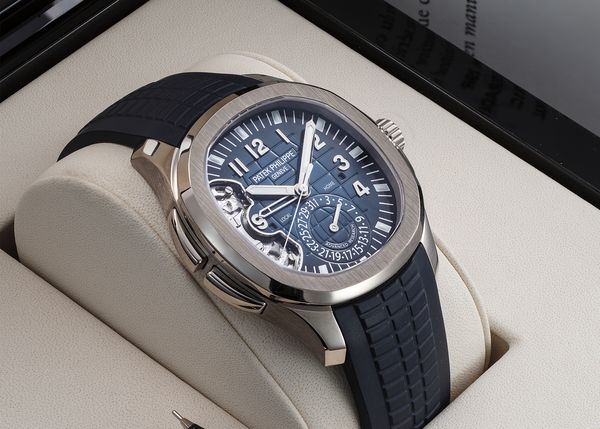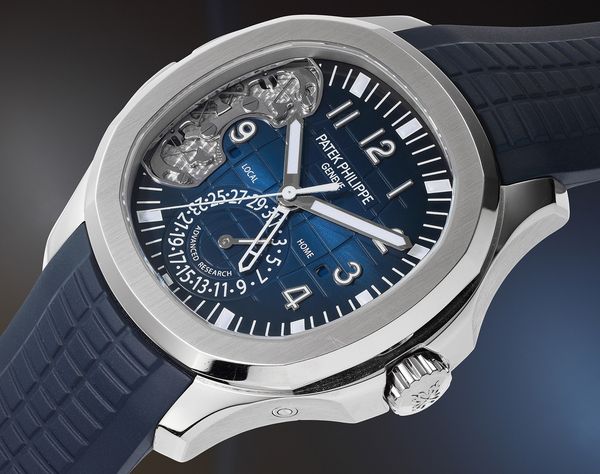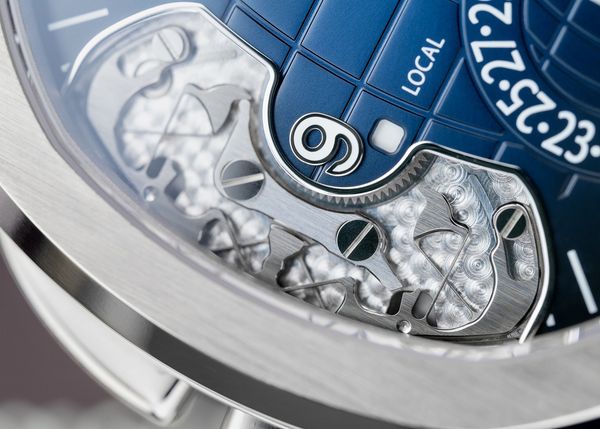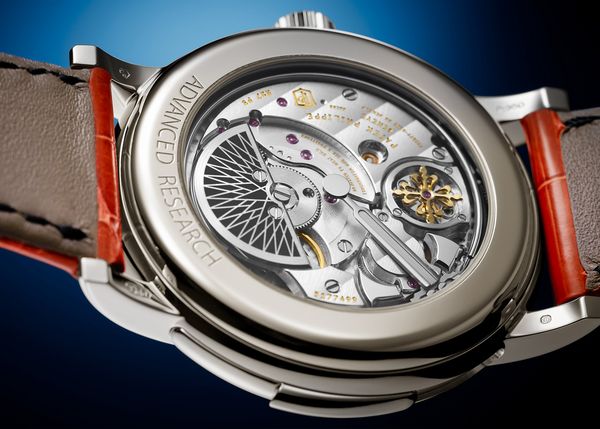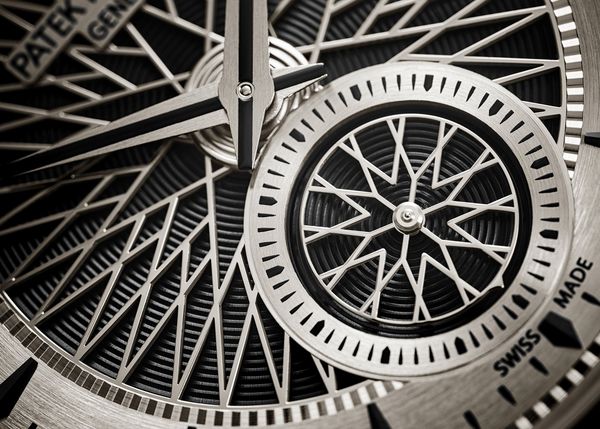The New York Watch Auction: EIGHT takes place on June 10 and 11, inside our Manhattan headquarters at 432 Park Avenue. The auction includes more than 120 of the world's finest watches, including a Patek Philippe Aquanaut Travel-Time ref. 5650G.
– By Logan Baker
It’s always exciting when Patek Philippe does something genuinely new.
The Geneva firm ended up at the very top of the Swiss watch world today thanks, in part, to its willingness to tackle daring feats of horology throughout its history, such as completing the Henry Graves Supercomplication in the first half of the 20th century.
The watchmaking landscape is a far different place today than it was then, and Patek Philippe is no longer required to "innovate or die" as it had to in the past. However, the company still has a few tricks up its sleeve, with one of its main points of experimental emphasis this century coming under the banner of its Advanced Research department.
“In 2005, we decided to create a new concept of Advanced Research,” Thierry Stern, President of Patek Philippe, says on the brand's website. “The idea behind this concept was to show the world all the watchmaking knowledge and mastery of Patek Philippe.”
The genesis of the Advanced Research department actually started earlier than 2005. It goes back to a corporate consortium that was formed in 2002 between Patek Philippe, Rolex, the Swatch Group, Ulysse Nardin, and the Swiss Center for Electronics and Microtechnology (CSEM), who came together to file – and receive – a patent for the production of thermally compensated silicon hairsprings.
Ulysse Nardin had revealed the world’s first wristwatch with escapement wheels made of silicon the previous year, with the boundary-pushing Freak – the rest of the Swiss watch industry wanted in. It’s rare for power players such as Rolex, the Swatch Group, and Patek Philippe to enter into an agreement of any sort, but the powers that be deemed silicon to be a revolutionary enough technology that they decided they would collaborate in kind.
One of the results of the consortium and patent was the creation of the Advanced Research department within Patek Philippe, in order for the company’s top watchmakers and material scientists to collaborate and develop new applications of silicon in watchmaking.
The benefits of silicon were already clear to them. It’s non-magnetic, it's resistant to corrosion and shocks, it will generally require no lubrication, it can be basically rendered any shape, and it's up to 60 percent harder and 70 percent lighter than a traditional metal like steel.
The Advanced Research department has now been a part of the Patek Philippe identity for 18 years, and there have been numerous limited-edition watches created specifically to highlight the company’s achievements and technical developments. To be precise, this high-concept horological laboratory has resulted in six different models to date.
Half of these watches were represented during the recent Geneva Watch Auction: XVII, and then another two popped up inside the Hong Kong Watch Auction: XVI and New York Watch Auction: EIGHT catalogs, so it felt like now is as good of a time as any to dig a bit deeper into what makes the six Advanced Research watches from Patek Philippe worth collecting.
The Patek Philippe Advanced Research Annual Calendar Ref. 5250G
Patek Philippe killed multiple birds with one stone in 2005 when releasing the Advanced Research Annual Calendar ref. 5250G. Not only did the new release serve as the first act for the Advanced Research collection as a whole, but it also represented the 10th anniversary of Patek’s introduction of the world’s first annual calendar.
A limited edition of just 100 pieces with a silvered dial using the brand’s traditional annual calendar format, the ref. 5250 housed the new self-winding caliber 315 S IRM QA LU SI inside its 18k white gold 39mm case. The movement featured a new silicon-based escape wheel inside of the otherwise traditional Swiss lever escapement assembly. To emphasize the new technology, Patek Philippe incorporated a “Cyclops”-like external magnifying glass positioned on the sapphire crystal exhibition caseback directly above the escapement.
The new escape wheel had a much lighter mass than previous steel constructions, which meant less energy was required throughout the gear train, potentially resulting in a more consistent amplitude over the lifespan of the watch's power reserve. The new escape wheel also met the standards of the Geneva Seal, which Patek still followed in most of its watches at the time. Patek Philippe decided to name its new escape wheel design, “Silinvar,” a contraction of the words “silicon” and “invariable.” (Silinvar is also the name of Patek Philippe’s proprietary mono-crystal silicon material.)
The Annual Calendar ref. 5250G had the smallest production of any Advanced Research model (100 pieces) until the release of the ref. 5750, in 2021. That said, the 5250G has still occasionally shown its face in the auction room.
The Patek Philippe Advanced Research Annual Calendar Ref. 5350G
Patek Philippe quickly followed the ref. 5250 one year later with the release of the Advanced Research Annual Calendar ref. 5350G.
For the second watch in the series, Patek continued the same overall format – a 39mm precious metal annual calendar in the brand’s recognizable dial composition, with the addition of a Silinvar escape wheel in the movement – but they changed the case material to 18k pink gold and incorporated a new Silinvar-based balance spring into the equation. Once again, Patek included the magnifying glass on the exhibition caseback to highlight the gradual escapement evolution.
The official name of this new balance spring? “Spiromax.”
The Spiromax spring had a lower mass and less sensitivity to the effects of gravity and external impacts, while also being significantly flatter than a conventional Breguet overcoil hairspring. It was designed to be more precise, more consistent, and just an overall better fit for a modern watch than the hairspring materials of previous generations. As a result, the Spiromax hairspring has likely seen the widest adoption of any Advanced Research invention across the rest of Patek Philippe’s collections, with most new movement introductions of the past decade or so including it.
The Annual Calendar Ref. 5350G was produced in a limited-edition batch of 300 watches, an increase in the production total from the previous year’s ref. 5250 release. Only three examples of the ref. 5250 have shown up at Phillips in the past (one in 2015, and two in 2016 – here and here), but an original-owner example is coming soon at the end of May, during the Hong Kong Watch Auction: XVI.
The Patek Philippe Advanced Research Annual Calendar Ref. 5450G
Patek Philippe waited two years before releasing another Advanced Research model, when the platinum-cased Annual Calendar ref. 5450P joined the collection in 2008.
The big news this time around was the introduction of the Silinvar-based “Pulsomax” escapement, which Patek Philippe said would increases the energy efficiency of the movement by up to 15 percent, through the improved design of the escape wheel and pallet fork within the escapement. The new silicon pallet forks were lighter and more stable than a traditional steel lever, and due to the smooth nature of silicon, there was now no part of the escapement that required lubrication, eliminating a traditional source of trouble for mechanical timekeepers.
The ref. 5450P has a salmon dial and was the first Advanced Research model cased in platinum (which means that, yes, a small diamond is set on the caseband at six o’clock), as well as the final annual calendar model in the collection, so far. It was also the last of the Advanced Research series to receive the Geneva Seal, as Patek Philippe would transition all of its watches to the new internal Patek Philippe Quality Seal in 2009.
The ref. 5450P had a limited production of 300 watches, yet it has historically been the least common example to come up for sale. Only one previous example has appeared at PHILLIPS, in 2020.
The Patek Philippe Advanced Research Perpetual Calendar Ref. 5550G
Patek Philippe returned to the Advanced Research series three years later, with the release of the Perpetual Calendar ref. 5550G, in 2011. They moved on from the annual calendar with this reference, but clearly Patek wasn’t ready to abandon the calendar complication completely. Out of the four Advanced Research calendar models, the ref. 5550 Perpetual Calendar is my personal favorite.
The platinum perpetual calendar served as the debut for Patek Philippe’s Oscillomax – which I’ve dubbed the “Mad Max” regulating ensemble – combining the Pulsomax escapement, the Spiromax balance spring, and the new GyromaxSi balance. It was more or less the sum of every previous Advanced Research development to date, executed in a more complicated and traditional design.
This new balance wheel was an evolution of Patek’s original Gyromax balance design, which is why the release of the ref. 5550G coincided with the 60th anniversary of the Gyromax’s creation. What makes the GyromaxSi different is the Silinvar construction that is outfitted with a pair of 24k gold rims and four poising screws made of gold. The design allows Patek to regulate the movement in a much simpler and more direct fashion.
The combination of the full Silinvar assembly allowed Patek to increase the power reserve of the new caliber 240 Q Si up to 70 hours, a big improvement from the 48 hours of autonomy found in the previous-gen caliber 240. Of course, Patek continued the tradition of the built-in magnifying glass on the exhibition caseback to show off its new Oscillomax construction.
The platinum ref. 5550 was actually a touch smaller than the three previous annual calendar references, with a 37mm diameter, and it had a satin-finished grey dial with gilt hands and applied baton hour markers.
A limited edition of 300 watches, the ref. 5550 Perpetual Calendar pops up for sale every so often. We’ve sold three previous examples – in 2015, in 2020, and then another in the recent Geneva Watch Auction: XVII.
The Patek Philippe Advanced Research Aquanaut Travel Time Ref. 5650G
After creating an entire regulating organ completely out of Silinvar, the Advanced Research department went dark for a few years. We weren’t sure if they would end up coming back. In 2017, however, six years after the release of the ref. 5550P, just in time for the 20th anniversary of the Aquanaut, Patek Philippe introduced the Aquanaut Travel Time ref. 5650G, the first – and only, so far – sport watch in the Advanced Research series.
The Aquanaut Travel Time ref. 5650G changed the game for Patek Philippe in multiple ways. It was the first Advanced Research model to not focus its core innovation on Silinvar, instead, it introduced a new design approach for the assembly of the second time-zone complication.
From the non-technical side, the ref. 5650G stood out as the first time Patek Philippe had ever skeletonized or partially skeletonized one of its sport watches. A window at nine o’clock opens up about a quarter of the total dial space, revealing the new travel-time complication below. And, as a limited edition of 500 watches, it was, at the time, one of the first examples in many years of Patek publicizing a production number for either of its popular sport models, the Aquanaut or the Nautilus.
The result of all these factors, as well as the overwhelming demand for luxury sport watches from Patek Philippe that heated up in the late 2010s and early 2020s, has made the ref. 5650G one of the most recognizable and sought-after Aquanauts ever created.
I’m not kidding – I’ve spoken with multiple major Patek Philippe collectors that believe the ref. 5650G has the potential to be a million-dollar watch in the future. It’s just that different than anything else Patek has ever offered, both in the history of its sport watches and within the Advanced Research series as a whole. We even saw a few auction results last spring that placed the ref. 5650G in the ballpark of the seven-figure club.
With all the hype and speculation, as well the fact that the ref. 5650G had the largest production run of any Advanced Research model to date, there has been a surplus of examples to recently hit the market. PHILLIPS has sold four at auction (one in 2018, two in 2022 – here and here, and then another during the recent Geneva Watch Auction: XVII), and another via Phillips PERPETUAL. An additional example of the ref. 5650G will be available during the New York Watch Auction: EIGHT.
What makes the second time-zone complication inside the ref. 5650G different, you might be wondering?
A conventional GMT complication involves a hinged joint-like system of metal components that takes up excess space and can be clunky in its use. The new design developed by Patek Philippe introduces a compliant system of flexible steel blades that removes the hinged elements in favor of a more elastic format utilizing leaf springs, making the jumping action of the second time-zone hand much more precise and robust.
It is thinner (1.24mm thickness, compared to 1.45mm) than previous travel-time complications used by Patek Philippe, and it uses far less components in its assembly (12 now, versus 37 in previous generations). And the components that are in place require zero lubrication, thanks to their general elasticity.
However, if you thought you were getting a new Advanced Research reference without any Silinvar updates, you would be sorely mistaken. Patek Philippe reworked the Spiromax hairspring design inside the ref. 5650, adding a new inner terminal curve that improves overall isochronism of the balance. This development allows for enhanced rate stability and an increase in overall timekeeping precision. Patek Philippe guarantees performance of the movement inside the ref. 5650 within –1 and +2 seconds per day.
The Patek Philippe Advanced Research Minute Repeater Ref. 5750P
The most recent addition to the Advanced Research series is both the most limited and the most complicated reference yet.
Announced in 2021 in a run of just 15 watches, the Minute Repeater ref. 5750P sees the brilliant minds in the Advanced Research department focusing their energy on evolvig Patek Philippe's most emblematic complication, the minute repeater.
The question they asked themselves when developing the ref. 5750 was: How can we amplify the chime of the minute repeater while maintaining its acoustic quality?
The approach the Advanced Research department ended up taking was to introduce a mechanical system that could increase the volume of the chime while also more effectively propagating it outside the watch. Patek choose the hardest road in choosing platinum for the ref. 5750’s case metal, which is famous in watchmaking circles for muffling the chime of any repeater due to its high density.
Patek didn’t totally reinvent the wheel, however, utilizing the overall architecture of the automatic minute-repeating caliber R 27 with micro-rotor, that dates back to the late 1980s. What’s new is a small metal tuning fork that connects to the gongs (which are now made of platinum instead of conventional steel) but also extends up to the center of the watch, positioned in the space between the movement and the dial. Here, the tuning fork is connected to a paper-thin oscillating disc made of sapphire crystal that measures just 0.2mm in height. Patek calls this tuning fork its “sound lever.”
What happens when the chime is activated is that the tuning fork assumes its natural role as a resonator by capturing the vibrations emitted from the gongs and transferring them to the sapphire disc, which oscillates freely, maintaining the original sound volume and quality, before emitting the chime through a series of four small openings at three, six, nine, and 12 o'clock in the upper titanium movement ring, before it finally reaches the outside of the case. This entire modular approach has been dubbed by Patek as its new “fortissimo ff” amplification system, and they’ve received four separate patents for it.
Outside the volume and the acoustics, the Advanced Research Minute Repeater ref. 5750P has an overall surprising aesthetic, moving away from the more conservative format of Patek’s traditional minute repeating wristwatches and into a more aggressive design. The 40mm platinum case has a domed bezel that is said to be influenced by the contemporary profile of the ref. 5178, but it’s the dial that feels the most surprising.
Patek says the five-piece dial featuring aggressive open spikes shooting out from its center is inspired by the spokes found on the wheels of certain vintage automobiles. The small seconds display has a similar design and is located at six o’clock, but it has no visible hand to indicate the passing time – instead, the seconds disc constantly rotates. A small triangle pokes outside the rest of the circular display and can be used, if needed, to track the precise passing seconds. And to top it all off, Patek paired the new watch with a bright orange alligator strap.
The Minute Repeater ref. 5750P is the most intricate and technically advanced model in the Advanced Research line to date. It’s also the rarest, and – presumably – the most expensive. With only 15 examples entering production, no MSRP was provided by Patek Philippe when the ref. 5750P was announced two years ago; instead, it was specifically highlighted by the brand as an “application piece.”
To my knowledge, zero examples of the ref. 5750P have made it to the public secondary market yet, but if one ever makes it to the auction floor, it will be fascinating to see how it performs.
There’s basically no precedent for a watch like the ref. 5750P from Patek Philippe.
You can learn more about and register to bid in the New York Watch Auction: EIGHT by visiting our online catalog.
The official Patek Philippe website also has a guide to the Advanced Research series that is worth reviewing for more information.
About Phillips In Association With Bacs & Russo
The team of specialists at PHILLIPS Watches is dedicated to an uncompromised approach to quality, transparency, and client service. Phillips in Association with Bacs & Russo holds the world record for the most successful watch auction, with its Geneva Watch Auction: XIV having realized $74.5 million in 2021. Over the course of 2021 and 2022, the company sold 100% of the watches offered, a first in the industry, resulting in the highest annual total in history across all the auction houses at $227 million.
About Logan Baker
Logan has spent the past decade working in watch-focused media, reporting on every aspect of the industry. He joined Phillips in Association with Bacs & Russo at the start of 2023 as the department's Senior Editorial Manager. He splits his time between New York and Geneva.
Recommended Reading
Ten Of The Most Important Modern Patek Philippes Included In The Geneva Watch Auction: XVII
Discovering A Pair Of Unique Patek Philippe Aquanaut Models
A Guide To The Patek Philippe Ref. 2499: The Art of Improving Upon Perfection
